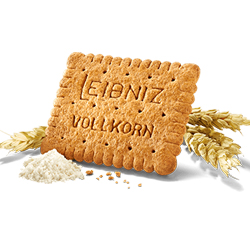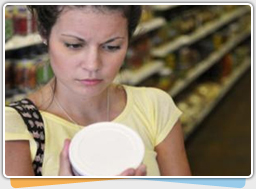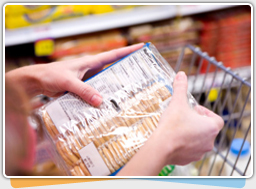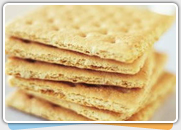Home »
Food & Recipes »
Diabetes Type 1 »
Reading Food Labels
Reading Food Labels
Become a wise shopper- Read your food label Example of reading nutrition labels
| Amount per 20g |
Daily Value % |
per 100g |
| Fat 3g |
5% |
15 |
Saturated fat 0.5g
+trans fat 1g |
8% |
2.5
5 |
| Cholesterol 0mg |
- |
- |
| Sodium 132mg |
6% |
660 |
| Carbohydrate 14g |
5% |
70 |
| Fiber 2g |
8% |
10 |
| Sugar 2g |
- |
10 |
| Protein 2g |
- |
- |
| Vitamin A 0% |
Vitamin C 0% |
- |
| Calcium 0% |
Iron 4% |
- |
Ingredients: Whole Wheat, Vegetable Oil, Shortening, Salt
Serving size
The first thing to do when you read a label is to check the serving size. All the information mentioned in the label is based on the serving size.This food label of crackers shows a serving size = 4, meaning that 4 crackers contains the above information.
Notice Some food labels provide the nutrition values only per 100 grams which requires you to calculate.
 Practice
Practice
- Check product's weight (always written in the package) in this case its 50g
- Get the weight of one cracker: divide 50g by the 10 crackers= 5g
- Compare it with the carbohydrate content of 100g crackers.
- 100 g crackers 70 g carbohydrate
- 5 g crackers x
- x = 70*5 / 100 = 3.5
Result: 1 cracker contains 3.5 g carbohydrates, so 2 crackers contain 7g
- Energy: shows the Kilocalories that the 4 crackers provides = 91Kcal.Daily value%: the daily value describes the percentage of nutrients found in this food item is based on a 2000Kcal diet. This food label shows for example that 4 crackers covers only 4% of the required iron that you need to take per day.
If you take more calorie than what your body needs, you will gain weight 


- Fat: Most of the food labels will mention the amount of the fat composition, such as in this example it mention saturated fat, trans fat and cholesterol. We should limit the saturated fat, trans fat and cholesterol since they are very harmful when taken in large amounts. As healthy guidelines suggest, saturated fat should not exceed 10% from your total daily intake (the 4 crackers here provides 8% so now you know it's very high), while cholesterol should not exceed 200 mg per day. Look for products with zero trans fat.
- Sodium: As mentioned above salt is the common name of sodium. Too much salt can cause high blood pressure which is dangerous to your health.
- Carbohydrates: All carbohydrates increase your blood glucose. You should look at the total grams carbohydrate. In this example, 4 crackers provides you with 14 grams of carbohydrates. Fibers and sugar are parts of carbohydrates so their content are already included.
- Protein: Proteins are needed for tissue buliding. Crackers are not a good source of protein.
- Ingredients: The order of mentioning the ingredients in the food label is not random. The ingredient list starts with the biggest ingredient of the product to the smallest ingredient. So here; the most content of the crackers is the whole wheat (carbohydrates).
REFERENCE
Since I have diabetes, what should I focus on while reading the food label
As you know, carbohydrates affect your blood sugar directly; therefore you need to read the amount of carbohydrates along with sugar and fibers. Additionally you need to consider two points.
- If food products contain more than 5g of fibers then it needs to be subtracted from the total amount of carbohydrates. For example: 1/2 cup corn contains 20g carbohydrates and 7g fibers, calculation will be 20-7=13g , so the total amount of carbohydrates provided by the corn is 13 g instead of 20. (Hence it is a good idea to add food with lots of fibers)
- If your diet food item includes sugar alcohol (artificial sweeteners),like Sorbitol, Xylitol, Mannitol or others, then you should subtract half their amount from the total carbohydrates. For example: a diet sweet bar contains 21g total carbohydrates of which 6g is sugar alcohol, so the actual carbohydrates= 21-3=18 grams.
REFERENCE



![]() Practice
Practice
